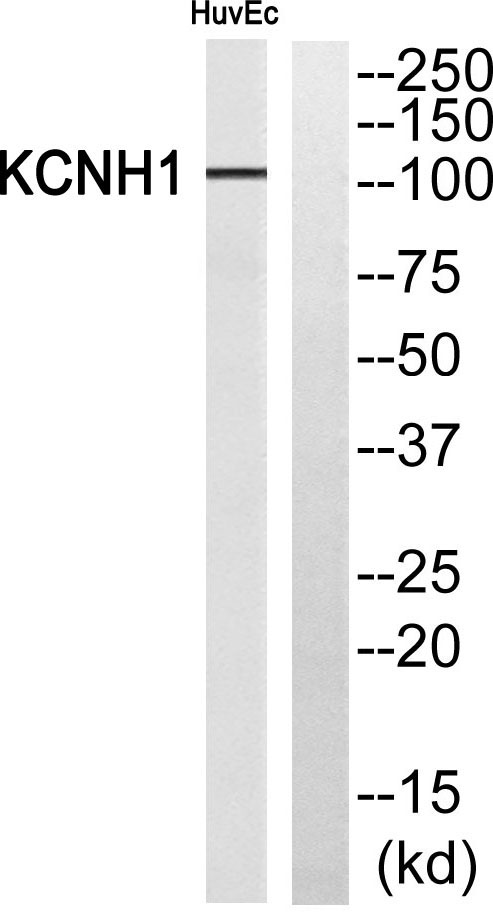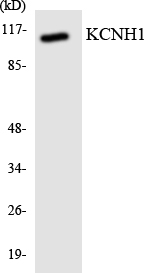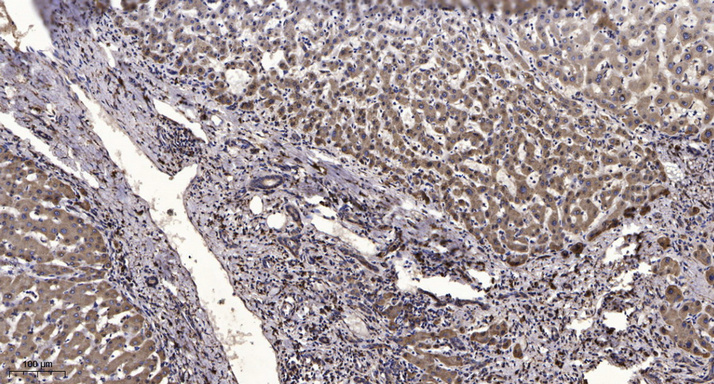KCNH1 Polyclonal Antibody
- Catalog No.:YT2456
- Applications:WB;ELISA;IHC
- Reactivity:Human;Mouse;Rat
- Target:
- KCNH1
- Gene Name:
- KCNH1
- Protein Name:
- Potassium voltage-gated channel subfamily H member 1
- Human Gene Id:
- 3756
- Human Swiss Prot No:
- O95259
- Mouse Gene Id:
- 16510
- Mouse Swiss Prot No:
- Q60603
- Rat Gene Id:
- 65198
- Rat Swiss Prot No:
- Q63472
- Immunogen:
- The antiserum was produced against synthesized peptide derived from human KCNH1. AA range:720-769
- Specificity:
- KCNH1 Polyclonal Antibody detects endogenous levels of KCNH1 protein.
- Formulation:
- Liquid in PBS containing 50% glycerol, 0.5% BSA and 0.02% sodium azide.
- Source:
- Polyclonal, Rabbit,IgG
- Dilution:
- WB 1:500-2000;IHC 1:50-300; ELISA 2000-20000
- Purification:
- The antibody was affinity-purified from rabbit antiserum by affinity-chromatography using epitope-specific immunogen.
- Concentration:
- 1 mg/ml
- Storage Stability:
- -15°C to -25°C/1 year(Do not lower than -25°C)
- Other Name:
- KCNH1;EAG;EAG1;Potassium voltage-gated channel subfamily H member 1;Ether-a-go-go potassium channel 1;EAG channel 1;h-eag;hEAG1;Voltage-gated potassium channel subunit Kv10.1
- Observed Band(KD):
- 110kD
- Background:
- Voltage-gated potassium (Kv) channels represent the most complex class of voltage-gated ion channels from both functional and structural standpoints. Their diverse functions include regulating neurotransmitter release, heart rate, insulin secretion, neuronal excitability, epithelial electrolyte transport, smooth muscle contraction, and cell volume. This gene encodes a member of the potassium channel, voltage-gated, subfamily H. This member is a pore-forming (alpha) subunit of a voltage-gated non-inactivating delayed rectifier potassium channel. It is activated at the onset of myoblast differentiation. The gene is highly expressed in brain and in myoblasts. Overexpression of the gene may confer a growth advantage to cancer cells and favor tumor cell proliferation. Alternative splicing of this gene results in two transcript variants encoding distinct isoforms. [provided
- Function:
- disease:Overexpression of EAG may confer a growth advantage to cancer cells and favor tumor cell proliferation.,domain:The segment S4 is probably the voltage-sensor and is characterized by a series of positively charged amino acids at every third position.,function:Pore-forming (alpha) subunit of voltage-gated non-inactivating delayed rectifier potassium channel. Channel properties may be modulated by cAMP and subunit assembly. Mediates IK(NI) current in myoblasts.,similarity:Belongs to the potassium channel family. H (Eag) subfamily.,similarity:Contains 1 cyclic nucleotide-binding domain.,similarity:Contains 1 PAC (PAS-associated C-terminal) domain.,similarity:Contains 1 PAS (PER-ARNT-SIM) domain.,subunit:The potassium channel is probably composed of a homo- or heterotetrameric complex of pore-forming alpha subunits that can associate with modulating beta subunits. Heteromultimer with K
- Subcellular Location:
- Cell membrane ; Multi-pass membrane protein . Nucleus inner membrane ; Multi-pass membrane protein . Cell projection, dendrite . Cell projection, axon . Cell junction, synapse, presynaptic cell membrane . Perikaryon . Cell junction, synapse, postsynaptic density membrane . Early endosome membrane . Perinuclear KCNH1 is located to NPC-free islands.
- Expression:
- Highly expressed in brain and in myoblasts at the onset of fusion, but not in other tissues. Detected in HeLa (cervical carcinoma), SH-SY5Y (neuroblastoma) and MCF-7 (epithelial tumor) cells, but not in normal epithelial cells.
- June 19-2018
- WESTERN IMMUNOBLOTTING PROTOCOL
- June 19-2018
- IMMUNOHISTOCHEMISTRY-PARAFFIN PROTOCOL
- June 19-2018
- IMMUNOFLUORESCENCE PROTOCOL
- September 08-2020
- FLOW-CYTOMEYRT-PROTOCOL
- May 20-2022
- Cell-Based ELISA│解您多样本WB检测之困扰
- July 13-2018
- CELL-BASED-ELISA-PROTOCOL-FOR-ACETYL-PROTEIN
- July 13-2018
- CELL-BASED-ELISA-PROTOCOL-FOR-PHOSPHO-PROTEIN
- July 13-2018
- Antibody-FAQs
- Products Images

- Western Blot analysis of various cells using KCNH1 Polyclonal Antibody diluted at 1:2000

- Western blot analysis of KCNH1 Antibody. The lane on the right is blocked with the KCNH1 peptide.

- Western blot analysis of the lysates from COLO205 cells using KCNH1 antibody.

- Immunohistochemical analysis of paraffin-embedded human liver cancer. 1, Antibody was diluted at 1:200(4° overnight). 2, Tris-EDTA,pH9.0 was used for antigen retrieval. 3,Secondary antibody was diluted at 1:200(room temperature, 45min).



